
Surviving the coronavirus crisis: Diné perspectives, Part 7
Diné doctor: ‘It was COVID right in front of me’
TUBA CITY
Dr. Sophina Calderon, a family physician at Tuba City Regional Health Care Corporation, said in the beginning of the pandemic Western Navajo saw a rapid rise in COVID-19 cases and the medical center quickly transitioned into emergency mode.
“The numbers spiked fast and it hit us hard,” said Calderon, who is also deputy chief of staff. “My routine of daily clinic mixed with administrative duties changed dramatically.”
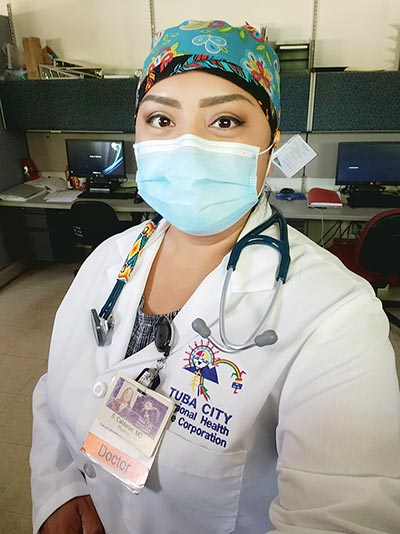
Courtesy photo
Dr. Sophina M. Calderon
Calderon said she has been impressed with the Epidemiology Response Team at TCRHCC, led by experts, two of whom were trained at the Centers for Disease Control and Prevention and two doctors who have been in the community for more than 30 years. “They kicked into gear so quickly and reorganized everything from the get-go,” she said. “We followed their lead and got a good handle on things.”
With the influx of COVID-19 patients to the hospital, Calderon jumped on the frontline, working in the Emergency Room as well as screening patients in the outdoor triage unit. “I was seeing sick COVID-19 patients in the ER, working 12-hour shifts at a time,” said Calderon. “It was COVID right in front of me. Getting close to patients, it becomes much more real.”
Calderon, who was born and raised in Tuba City, said it was painful to see some of her patients from the outpatient clinic coming in with the virus. “It hit me more dramatically because I saw people who I recognized, sometimes family members,” she said. “It was hard to settle with.”
The early stages of COVID-19 were scary, she said, because there were so many uncertainties about the virus and how to treat it. Since the initial rush, things have calmed and the numbers for Tuba City have trended downward, she said. “We’re all used to our roles and we’re comfortable with what we’re doing,” said Calderon. “We’re sort of settled in for the marathon portion of this rather than the sprint in the beginning.”
‘Not much has changed’
Calderon said there were vulnerabilities with the spike in coronavirus cases in Arizona, especially with people bringing the virus home to their families, and isolating them can be a challenge.
“Our contact tracers and team members are spending long amounts of time talking to families and individualizing advice about how to prevent other people in the house from getting it,” she said.
Calderon said the pandemic has highlighted all the deficiencies and inadequacies that were accepted as normal pre-COVID-19, such as poor access to water, electricity and transportation. “I thought back to when I was a kid and not much has changed,” she said.
Her own parents still live without running water. Calderon now lives in medical staff housing behind the hospital with her husband and two children where they keep strict safety protocols. “It’s really hard,” she said. “We’ve kind of gotten used to it now. We’ve established a routine.”
She said it is helpful to be around others who work at the hospital and understand the challenges. “We’re all on the same page,” she said. “We’re all in this together.” However, Calderon says her kids miss seeing their grandparents. “They really love going to see their masani and cheii,” she said. “Our family members are all right here but we can’t see them.”
They do their best to stay in touch by phone and social media, she said. “People really have to keep their guard up, not get close to other people, and avoid use of any public spaces,” said Calderon. She encourages everyone to keep wearing their masks, washing their hands, using sanitizer, and avoid gatherings and travel. “Try to stick to the things you have to do like going to the grocery store and post office,” she said.
Good communication is key
Calderon said one of the most important things to her is to make sure the community feels well connected to the hospital and informed about the medical treatment they can receive there. And key to that is keeping open lines of communication with the communities TCRHCC serves, which has been integral to the success of its response to COVID-19, said Calderon.
As a public service, the Navajo Times is making all coverage of the coronavirus pandemic fully available on its website. Please support the Times by subscribing.
How to protect yourself and others.
Why masks work. Which masks are best.
Resources for coronavirus assistance
“We’ve tried to stay connected to chapters in our service unit to communicate what’s going on here on the ground, especially if we’re seeing trends as the results of our contact tracing,” said Calderon. “That way the community can receive clear messages about how they can alter their activities.”
Her team has been releasing newsletters, doing radio and video updates and distributing flyers, making sure information is uniform and consistent. Calderon said she also helps to educate providers at the hospital from a cultural perspective.
“We have a special population of people that we serve here,” she said. By the same token, Calderon encourages patients to ask questions. “To me, the more they realize we are tailoring services to help them and doing the best we can for them, that matters to me most,” said Calderon.
High standards
Calderon said there’s been a lot of “buzz” about how flu season mixed with COVID-19 could be very difficult because it might cause confusion. On the plus side, she said, there’s hope that the measures that everyone has been taking to mitigate the spread of COVID-19 will also protect against flu, she said, which is similarly contracted through droplets, touching surfaces and touching the face and nose.
“Our distancing and masking protocols will hopefully help mitigate the spread of flu,” said Calderon. As far as testing supplies, Calderon said TCRHCC is in good shape. “We are now at a phase where we have plenty of tests, which is really different from early on in the pandemic,” she said. “We have expanded testing criteria and it’s pretty wide open now.”
She said the subject of asymptomatic carriers of COVID-19 continues to be problematic. “That has been challenging because there are plenty of people who are still spreading it and not knowing it,” she said. While Calderon does not provide inpatient hospital care, which is done by internal medicine doctors, she said a variety of medications are available to treat COVID-19 at TCRHCC, including steroids for inflammation, antibiotics for secondary bacterial infection, and Remdesivir – although there is still no cure for COVID-19.
Calderon said the TCRHCC team has been strict in looking at data and studies and following guidance from reputable sources like the CDC when it comes to treating the disease. “Instead of following anecdotal evidence, we wait for hard data to come out,” she said. “We have to make sure that we are convinced that things are safe and that they’re actually useful.”
She said TCRHCC is less likely to try treatments that haven’t been proven yet. “We hold ourselves to a high standard, especially because there’s a lot of bad history of our people here with respect to the government,” she said. “Because we care so much about the people, we really want to make sure that the things we’re doing are going to be good for them.”
Calderon said TCRHCC is in its first phase of reopening regular services, which required the hospital and clinics to have enough Personal Protective Equipment and testing kits. She said while their outpatient clinics are beginning to reopen, some things have changed, like they see might patients spaced out without any overlap in appointments, and often do follow-up visits by telephone.
Now, the whole outpatient primary care building is a “Green Zone,” meaning a non-COVID-19 area, which houses services like general surgery, orthopedics and podiatry. Calderon said the urgent care, family medicine, internal medicine, OB-GYN and pediatric clinics have stayed open through the pandemic with strict screening. “Patients need to ‘screen green,’” she said.
Anyone who has had contact with a COVID-19 positive person or is awaiting test results can’t come into the Green Zone, she said, and all surgery patients are tested prior to a procedure. “We try to keep as COVID safe as possible,” she said.
‘An emotional toll’
Calderon said for those with COVID-19 who have not needed to be hospitalized she’s pretty much seen a 100% recovery without ongoing after-effects. For patients who’ve needed hospital support like oxygen therapy, many have had extended recoveries with ongoing respiratory issues like shortness of breath and have needed oxygen after they are discharged.
Still, she said, most recover fully and wean themselves off of oxygen within a couple of weeks. Critically ill patients who were intubated generally require more extensive rehabilitation therapy, she said.
In other words, the more severe the COVID-19 infection, the longer the recovery. Other than respiratory symptoms, Calderon has observed that the other significant after-effect for COVID-19 survivors is related to mental health. “It’s had a significant impact on them, from the time they were isolated without family in the hospital and a disbelief of how sick they got,” she said. “It blew them away and they have an emotional scar.”
The trauma of the illness and being displaced from their homes can linger, she said. “Some say they can’t sleep at night and they still get nervous that they won’t wake up,” said Calderon. “It takes an emotional toll. I feel like that’s been a bit more dramatic than physical after-effects.”
‘Hitting the reset button’
Calderon said many people who rely on traditional prayers for their emotional, and spiritual well-being are yearning for help and healing. “At a time when we’re so anxious and depressed and isolated, our mental health takes a hit,” she said.
She’s been working with traditional healers and medicine men to develop safety guidelines for ceremonial practices in consultation with the CDC, which are also being reviewed by the Navajo Nation. In the traditional Navajo mindset, getting sick is related to an imbalance of something in your life, she said, and the only way to fix those things is through ceremonial prayer and sweat lodge.
“Some people are doing these things regardless so we thought it would be good to provide some guidance on how to do them safer,” said Calderon.
She said many medicine men have been very good at self-regulating during the pandemic and have declined to preside over ceremonies that patients have asked for. Some have used technology to do prayers by phone or used personal belongings of patients to do a ceremony without the person to be there. “A lot of these prayers that are being done for patients who are perhaps hospitalized are being done remotely,” she said.
In reviewing the guidelines with the CDC, they are looking at it from a medical and scientific perspective, said Calderon. “We’re teaming up with scientific minds and cultural expertise to create this guidance,” she said.
Calderon said in her conversations with medicine men, some say the imbalance associated with the COVID-19 is more of a global issue than an individual one. “There’s a disturbance of some kind that has caused us to get sick and suffer from this virus,” she said. This is a belief shared by many indigenous cultures, she added.
“It’s like the entire Navajo Nation needs one big ceremony, or a special tactic to combat the virus, because it’s nothing like anything they’ve dealt with before,” she said. “It’s more of a population-wide event.” Calderon said many are looking forward to the point when the pandemic has passed, when they can reflect back on COVID-19 and say, “This is what we learned from it.”
“It’s kind of like hitting the reset button,” she said. “We need to maintain a balance from this point forward and make some positive changes.”
Dr. Sophina M. Calderon is a graduate of Dartmouth College, with a medical degree from University of Rochester School of Medicine.

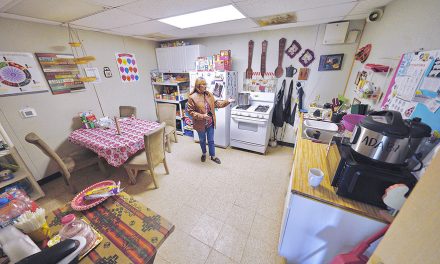
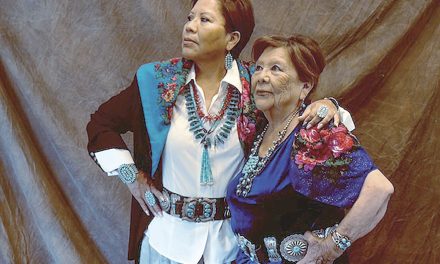
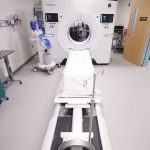
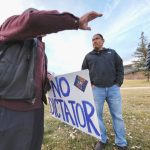



 Highway 264,
Highway 264, I-40, WB @ Winslow
I-40, WB @ Winslow